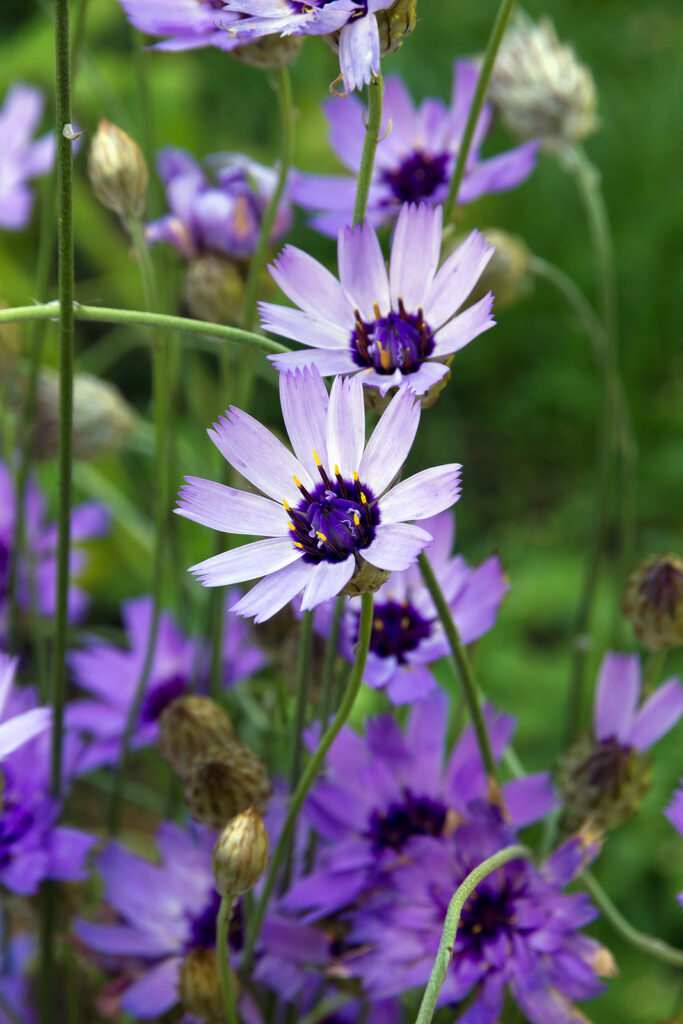Cupid’s dart, Catananche caerulea, is an old-fashioned summer-blooming perennial. Solitary lilac-blue or white ray flowers are borne atop wiry stems.
Catananche produces mounds of grayish-green, lance-shaped leaves. The flower clusters have strap-shaped ray florets and usually come in lavender blue but sometimes white or yellow as well.
Catananche is a good choice for the front or middle of a flower border. Catananche flowers can be dried for winter decoration.
Get to know Catananche – Cupid’s Dart
- Plant type: Perennial
- Growing zones and range: Zones 3 to 8
- Hardiness: Hardy to -30°F (-34°C)
- Height and width: 12 to 24 inches (30-61cm) tall and wide; grows in mounds or tufts
- Foliage: Narrow gray-green leaves, 8 to 12 inches long mostly at the base of a leafless stem; leafless 24-inch (61cm) stems
- Flowers: Lavender blue or white flowerheads to 2 inches across similar to cornflowers with straw-like, shining bracts; flowers also in white and yellow.
- Flower colors: Blue, white
- Bloom time: Summer
- Uses: Flower borders, cutting, dried flowers
- Common name: Cupid’s dart
- Botanical name: Catananche
- Family name: Asteraceae
- Origin: Mediterranean
Where to plant Catananche – Cupid’s Dart
- Grow Catananche in full sun or very light shade.
- Catananche grows best in humus-rich, well-drained soil.
Catananche uses and companions
- Use Catananche in a sunny border.
- Catananche flowers are good for cutting and drying.
- Good garden companions for Catananche include Anthemis, Armeria, Lychnis coronaria, Oenothera, Sysyrinchium striatum.
When to plant Catananche – Cupid’s Dart
- Set container-grown plants in the garden in spring after the last frost.
- Sow seed indoors in late winter for bloom the first year.
- Sow seed outdoors where plants are to grow in mid-spring.
Planting and spacing Catananche – Cupid’s Dart
- Space Catananche 18 to 24 inches (45-61cm) apart.
How to water and feed Catananche – Cupid’s Dart
- Keep the soil evenly moist for best blooms.
- Fertilize Catananche with an all-purpose fertilizer in spring.

Catananche care
- Remove faded flowers to prolong bloom time.
- Divide clumps every two years in early spring to keep plants vigorous.
Catananche pests and diseases
- Catananche is usually pest and disease free.
Catananche propagation
- Catananche seeds germinate in about 21 days at 68°F (20°C).
- Propagate Catananche by division.
- Propagate by root cuttings in winter.
Catananche varieties to grow
- Catananche caerulea, cupid’s dart: Grows 18 to 24 inches (45-61cm) tall; grassy 12-inch leaves; bears solitary 1- to 2-inch wide lilac-blue flowers atop wiry stems in midsummer; cultivars include ‘Alba’ which has white flowers and ‘Major’ which has deep lavender-blue flowers.



